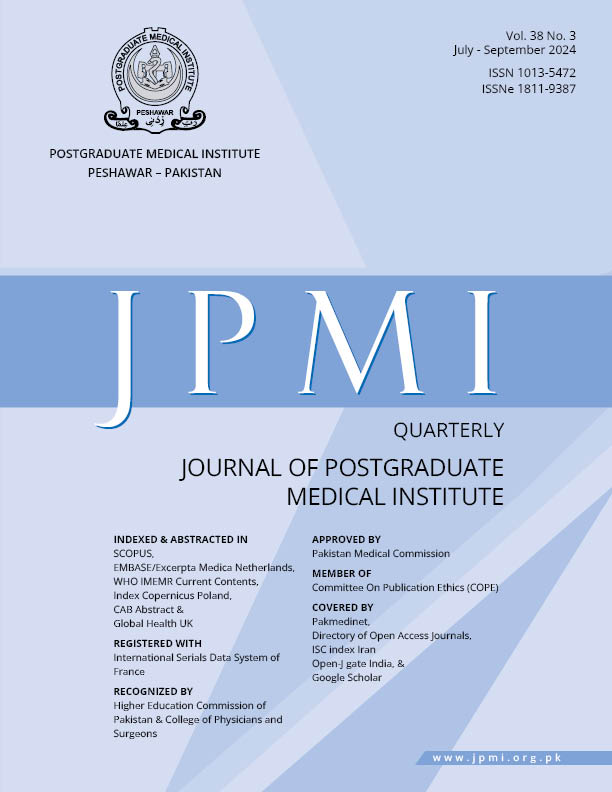Clinical Evaluation of Bulk-Fill Flowable Composite versus Traditional Nano-Hybrid Composites in Posterior Teeth
Main Article Content
Abstract
Objective: To evaluate and compare the clinical performance of bulk-fill flowable composites and conventional nano-hybrid composites to restore posterior teeth.
Methodology: A Randomized controlled trial was conducted at Bakhtawar Amin Dental College, Multan, from July 2022 to Jun 2023. A total of 140 subjects were included in the study, with 70 assigned to the bulk-fill flowable composite group (Group A) and 70 to the traditional composite group (Group B). The restorations were assessed for retention, marginal integrity, and postoperative sensitivity over a 3-month follow-up period. Data was analyzed with SPSS version 26.0.
Results: 28 teeth were dropped out of the study, leaving 112 teeth. No significant differences were found between the two groups (A and B) in restoration outcomes according to USPHS criteria (taking p > 0.05 as significant), with chi-square values of 1.46 (p = 0.48), 2.53 (p = 0.28), and 3.77 (p = 0.15) for restoration retention, marginal integrity, and postoperative sensitivity, respectively.
Conclusion: Both bulk-fill flowable composite and traditional composite materials in posterior teeth restorations show favorable clinical performance in terms of restoration retention and marginal integrity with minimal post-operative sensitivity. However, further research is needed to assess the long-term performance of these materials.
Article Details
Work published in JPMI is licensed under a
Creative Commons Attribution-NonCommercial 2.0 Generic License.
Authors are permitted and encouraged to post their work online (e.g., in institutional repositories or on their website) prior to and during the submission process, as it can lead to productive exchanges, as well as earlier and greater citation of published work.
References
Ilie N, Hickel R. Investigations on a methacrylate-based flowable composite based on the SDR™ technology. Dent Mater. 2011;27(4):348-55. DOI: 10.1016/j.dental.2010.11.014.
Sekundo C, Fazeli S, Felten A, Schoilew K, Wolff D, Frese C. A randomized clinical split-mouth trial of a bulk-fill and a nanohybrid composite restorative in class II cavities: Three-year results. Dent Mater. 2022;38(5):759-68. DOI: 10.1016/j.dental.2022.02.005.
Flury S, Peutzfeldt A, Lussi A. Influence of increment thickness on microhardness and dentin bond strength of bulk fill resin composites. Dent Mater. 2014;30(10):1104-12. DOI: 10.1016/j.dental.2014.07.001.
Ilie N, Bucuta S, Draenert M. Bulk-fill resin-based composites: an in vitro assessment of their mechanical performance. Oper Dent. 2013;38: 618-25. DOI: 10.2341/12-395-L.
Benetti AR, Havndrup-Pedersen C, Honore D, Pedersen MK, Pallesen U. Bulk-fill resin composites: polymerization contraction, depth of cure, and gap formation. Oper Dent.2015;40:190-200. DOI: 10.2341/13-324-L.
Ilie N, Hickel R. Investigations on mechanical behaviour of dental composites. Clin Oral Investig.2009;13:427-38. DOI: 10.1007/s00784-009-0258-4.
Francis A, Braxton A, Ahmad W, Tantbirojn D, Simon J, Versluis A. Cuspal flexure and extent of a bulk-fill flowable base composite cure. Oper Dent.2015;40:515-23.DOI: DOI: 10.2341/14-235-L.
Van Ende A, De Munck J, Van Landuyt K, Van Meerbeek B. bulk-filling affects the bonding efficacy in occlusal Class I cavities. J Adhes Dent.2016;18:119-24.DOI: 10.3290/j.jad.a35636.
Kaida K, Kubo S, Egoshi T, Taira Y. Eight-year clinical evaluation of two types of resin composite in non-carious cervical lesions. Clin Oral Investig.2022;26:6327-37. DOI:10.1007/s00784-022-04587-7.
Van Dijken JWV, Pallesen U. 2016: Posterior bulk-filled resin composite restorations: A 5-year randomized controlled clinical study. J Dent.2016;51:29-35. DOI: 10.1016/j.jdent.2016.06.002.
Agarwal RS, Hiremath H, Agarwal J, Garg A. Evaluation of cervical marginal and internal adaptation using newer bulk fill composites: An in vitro study. J Conserv Dent.2015;18:56-61. DOI: 10.4103/0972-0707.148897.
Roggendorf MJ, Kramer N, Appelt A, Naumann M, Frankenberger R. Marginal quality of flowable 4-mm base vs. conventionally layered resin composite. J Dent.2011;39:643-47.DOI: 10.1016/j.jdent.2011.07.004.
Microleakage at enamel and dentin margins with a bulk fill flowable resin (Scotti N, Comba A, Gambino A, Paolino DS, Alovisi M, Pasqualini D, Berutti E, Eur J Dent. 2014; 8:1-8.DOI: 10.4103/1305-7456.126230.
Jasinski P, Sobiech P, Korporowicz E, Gozdowski D, Olczak-Kowalczyk D. Clinical evaluation of restorative materials for primary teeth. European Academy of Pediatric Dentistry, Strasbourg, 2012, OPD:185.


